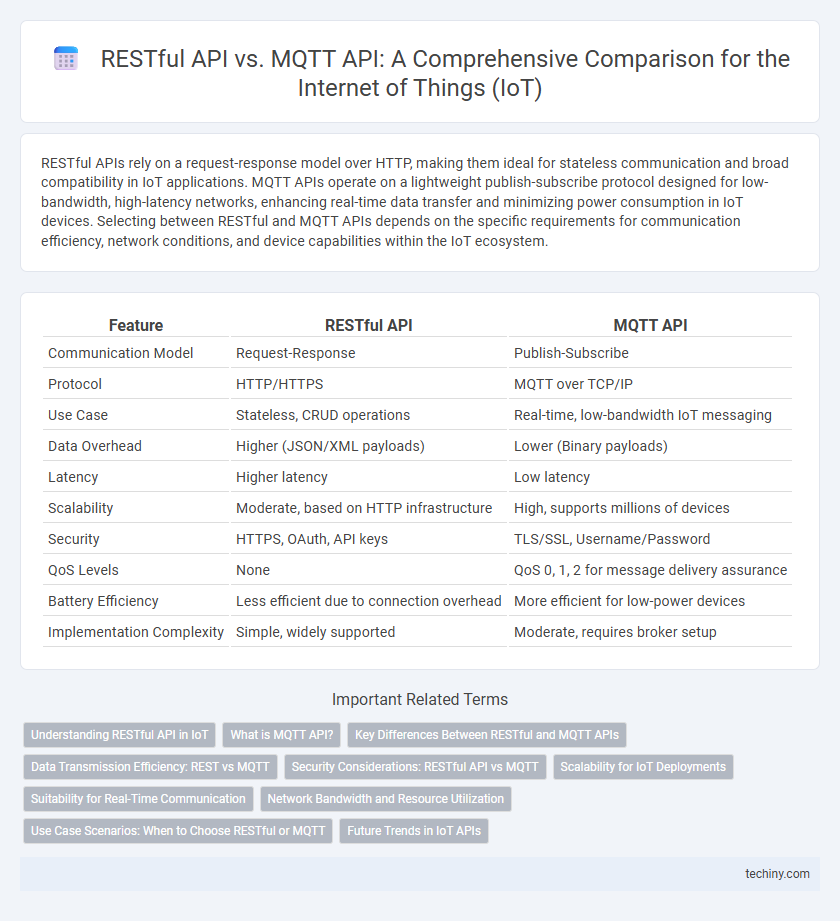RESTful APIs rely on a request-response model over HTTP, making them ideal for stateless communication and broad compatibility in IoT applications. MQTT APIs operate on a lightweight publish-subscribe protocol designed for low-bandwidth, high-latency networks, enhancing real-time data transfer and minimizing power consumption in IoT devices. Selecting between RESTful and MQTT APIs depends on the specific requirements for communication efficiency, network conditions, and device capabilities within the IoT ecosystem.
Table of Comparison
| Feature | RESTful API | MQTT API |
|---|---|---|
| Communication Model | Request-Response | Publish-Subscribe |
| Protocol | HTTP/HTTPS | MQTT over TCP/IP |
| Use Case | Stateless, CRUD operations | Real-time, low-bandwidth IoT messaging |
| Data Overhead | Higher (JSON/XML payloads) | Lower (Binary payloads) |
| Latency | Higher latency | Low latency |
| Scalability | Moderate, based on HTTP infrastructure | High, supports millions of devices |
| Security | HTTPS, OAuth, API keys | TLS/SSL, Username/Password |
| QoS Levels | None | QoS 0, 1, 2 for message delivery assurance |
| Battery Efficiency | Less efficient due to connection overhead | More efficient for low-power devices |
| Implementation Complexity | Simple, widely supported | Moderate, requires broker setup |
Understanding RESTful API in IoT
RESTful API in IoT facilitates seamless communication between devices by using standard HTTP methods like GET, POST, PUT, and DELETE, enabling easy integration and interoperability. It supports stateless operations, making it efficient for request-response communication and allowing scalability in IoT ecosystems. RESTful APIs are ideal for scenarios where real-time data is not critical, providing reliability and simplicity for IoT device management and data retrieval.
What is MQTT API?
MQTT API is a lightweight messaging protocol designed for efficient communication between Internet of Things (IoT) devices, using a publish-subscribe architecture that minimizes bandwidth and power consumption. It enables real-time data exchange in constrained environments by maintaining persistent TCP connections and supporting Quality of Service (QoS) levels for reliable message delivery. MQTT API is ideal for scenarios requiring low latency, scalable device interactions, and intermittent network connectivity.
Key Differences Between RESTful and MQTT APIs
RESTful APIs use HTTP for communication, making them stateless and ideal for request-response interactions with web services. MQTT APIs operate on a lightweight publish-subscribe protocol optimized for low-bandwidth, high-latency networks, enabling efficient real-time messaging between IoT devices. Key differences include RESTful API's synchronous communication versus MQTT's asynchronous messaging, and REST's higher overhead compared to MQTT's minimal packet size designed for constrained environments.
Data Transmission Efficiency: REST vs MQTT
MQTT API excels in data transmission efficiency for Internet of Things (IoT) applications due to its lightweight protocol and minimal header size, reducing network bandwidth usage compared to RESTful API's HTTP-based communication. RESTful API, while widely compatible and easy to implement, involves larger message formats and stateless request-response cycles that increase latency and overhead in frequent or real-time data exchanges. IoT deployments with constrained devices and limited network resources benefit significantly from MQTT's publish-subscribe model, which optimizes throughput and lowers power consumption.
Security Considerations: RESTful API vs MQTT
RESTful API employs HTTPS for secure communication, leveraging established web security standards such as SSL/TLS encryption and OAuth for robust authentication and authorization. MQTT typically uses TLS encryption to secure data transmission and supports client certificate authentication, but its lightweight nature can expose vulnerabilities if not properly configured. Security in IoT environments requires careful implementation of access controls, encryption protocols, and regular updates to protect RESTful APIs and MQTT brokers from threats like man-in-the-middle attacks and unauthorized access.
Scalability for IoT Deployments
RESTful API offers scalability through stateless communication and widespread HTTP support, making it suitable for large-scale IoT deployments with diverse devices. MQTT API excels in scalability with lightweight messaging, low bandwidth consumption, and efficient handling of numerous resource-constrained devices. The choice between RESTful API and MQTT API hinges on the specific IoT deployment requirements for scalability, network reliability, and device capabilities.
Suitability for Real-Time Communication
MQTT API is highly suitable for real-time communication in Internet of Things (IoT) due to its lightweight protocol, low bandwidth consumption, and efficient message delivery with Quality of Service levels. RESTful API, while widely used for web services, is less efficient for real-time IoT applications because it relies on stateless HTTP requests, which introduce latency and overhead. MQTT's publish-subscribe architecture supports instant data transmission, making it ideal for time-sensitive IoT scenarios.
Network Bandwidth and Resource Utilization
MQTT API significantly reduces network bandwidth consumption by using a lightweight publish-subscribe protocol designed for constrained devices, making it ideal for IoT scenarios with limited resources. RESTful API relies on HTTP methods and typically consumes more bandwidth due to verbose headers and stateless request-response cycles, leading to higher resource utilization. For IoT applications prioritizing minimal network load and efficient energy use, MQTT offers superior performance in managing resource-constrained environments.
Use Case Scenarios: When to Choose RESTful or MQTT
RESTful APIs are ideal for applications requiring stateless communication, such as web services and systems needing request-response patterns with guaranteed delivery and scalability. MQTT APIs excel in low-bandwidth, high-latency, or unreliable network environments typical of IoT sensor networks, enabling efficient publish-subscribe messaging with minimal overhead. Choose RESTful for synchronous operations and standard web integration, while MQTT suits real-time, event-driven scenarios demanding lightweight, continuous data exchange.
Future Trends in IoT APIs
RESTful API and MQTT API represent two dominant paradigms in IoT communication, with RESTful APIs offering stateless, resource-oriented interactions ideal for web integration, while MQTT APIs provide lightweight, publish-subscribe messaging optimized for low-bandwidth, real-time data exchange. Future trends in IoT APIs indicate a growing convergence where hybrid protocols will emerge, leveraging REST's simplicity and MQTT's efficiency to support massive IoT deployments with enhanced scalability and security. The rise of edge computing and AI-driven analytics will further drive APIs to adopt adaptive, context-aware capabilities, ensuring seamless interoperability in increasingly complex IoT ecosystems.
RESTful API vs MQTT API Infographic

 techiny.com
techiny.com